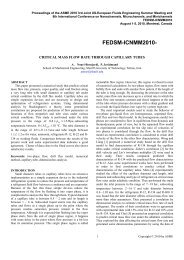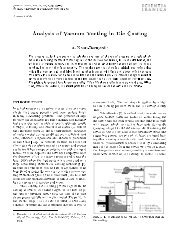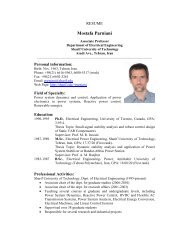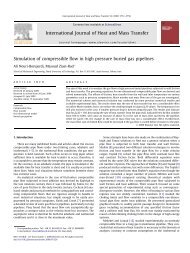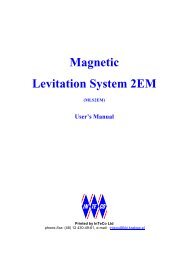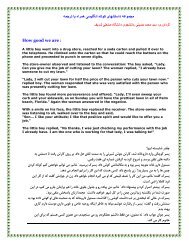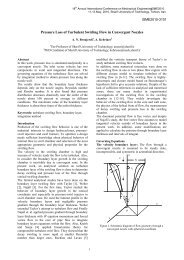A simple method of generating equations of state for hard sphere fluid
A simple method of generating equations of state for hard sphere fluid
A simple method of generating equations of state for hard sphere fluid
Create successful ePaper yourself
Turn your PDF publications into a flip-book with our unique Google optimized e-Paper software.
Chemical Physics 333 (2007) 208–213www.elsevier.com/locate/chemphysA <strong>simple</strong> <strong>method</strong> <strong>of</strong> <strong>generating</strong> <strong>equations</strong> <strong>of</strong> <strong>state</strong> <strong>for</strong> <strong>hard</strong> <strong>sphere</strong> <strong>fluid</strong>Mehrdad Khanpour a, *, G.A. Parsafar ba Department <strong>of</strong> Chemistry, Islamic Azad University, Amol Branch, Amol, Iranb Department <strong>of</strong> Chemistry, Sharif University <strong>of</strong> Technology, Tehran, IranReceived 15 November 2006; accepted 31 January 2007Available online 7 February 2007AbstractWe present in this paper a <strong>simple</strong> <strong>method</strong> <strong>of</strong> obtaining various <strong>equations</strong> <strong>of</strong> <strong>state</strong> <strong>for</strong> <strong>hard</strong> <strong>sphere</strong> <strong>fluid</strong> in a <strong>simple</strong> unifying way. Usingthe first several virial coefficients <strong>of</strong> <strong>hard</strong> <strong>sphere</strong> <strong>fluid</strong>, we will guess <strong>equations</strong> <strong>of</strong> <strong>state</strong> by using the asymptotic expansion <strong>method</strong>. Amongthe <strong>equations</strong> <strong>of</strong> <strong>state</strong> obtained in this way are Percus–Yevick, Scaled Particle Theory, and Carnahan–Starling <strong>equations</strong> <strong>of</strong> <strong>state</strong>. Also bycombining the Monte Carlo results on <strong>hard</strong> <strong>sphere</strong> <strong>fluid</strong> with the asymptotic expansion <strong>method</strong> many other <strong>equations</strong> <strong>of</strong> <strong>state</strong> <strong>for</strong> <strong>hard</strong><strong>sphere</strong> <strong>fluid</strong> can be found where all <strong>of</strong> them give essentially similar results in the region <strong>of</strong> isotropic <strong>hard</strong> <strong>sphere</strong> liquid, i.e., up to g < 0.5,in which g is the packing fraction. In addition we have found a <strong>simple</strong> equation <strong>of</strong> <strong>state</strong> <strong>for</strong> the <strong>hard</strong> <strong>sphere</strong> <strong>fluid</strong> in the metastable regionwhich represents the simulation data accurately.Ó 2007 Elsevier B.V. All rights reserved.Keywords: Equation <strong>of</strong> <strong>state</strong>; Hard <strong>sphere</strong> <strong>fluid</strong>1. IntroductionHard <strong>sphere</strong> <strong>fluid</strong> plays a central role in almost all theories<strong>of</strong> liquid <strong>state</strong> chemical physics, <strong>for</strong> example, in perturbationtheories [1–3], in statistical associating <strong>fluid</strong>theories [4], etc. For this reason its thermodynamic propertieshas been studied by various <strong>method</strong>s; scaled particletheory [5], integral equation theories, especially Percus–Yevick equation [6,7], and calculation <strong>of</strong> its virialcoefficients [8]. By these <strong>method</strong>s one can obtain the mostimportant quantity <strong>of</strong> interest; the equation <strong>of</strong> <strong>state</strong>, bywhich one can calculate all thermodynamic properties.Scaled particle theory generates the following equation <strong>of</strong><strong>state</strong>:Z ¼ 1 þ g þ g2ð1Þð1 gÞ 3where Z(=P/qkT) is the compressibility factor, g ¼ p qr3 6is the packing fraction, q is the number density, P is the* Corresponding author.E-mail address: mtankhanpour@yahoo.com (M. Khanpour).pressure, T is the absolute temperature, r is the diameter<strong>of</strong> <strong>hard</strong> <strong>sphere</strong>, and k is the Boltzmann constant.Wertheim and Thiele solved the Percus–Yevick [6,7]equation and obtained two <strong>equations</strong> <strong>of</strong> <strong>state</strong>; one <strong>for</strong>mwhich is obtained through compressibility route is Eq. (1)and the second one originated from virial route is1 þ 2g þ 3g2Z ¼ ð2Þð1 gÞ 2When expanding Eqs. (1) anf (2) in terms <strong>of</strong> g, one can find:Z ¼ 1 þ 4g þ 10g 2 þ 19g 3 þ 31g 4 þ 46g 5 þ 64g 6 þ 85g 7 þ Oðg 8 Þð3ÞandZ ¼ 1 þ 4g þ 10g 2 þ 16g 3 þ 22g 4 þ 28g 5 þ 34g 6þ 40g 7 þ Oðg 8 ÞIt is seen that both <strong>equations</strong> produce exact virial coefficientsup to third term only. As we may know the first severalvirial coefficients <strong>of</strong> the <strong>hard</strong> <strong>sphere</strong> <strong>fluid</strong> are [9]:B 2 =4, B 3 = 10, B 4 = 18.36, B 5 = 28.23, B 6 = 39.54,ð4Þ0301-0104/$ - see front matter Ó 2007 Elsevier B.V. All rights reserved.doi:10.1016/j.chemphys.2007.01.023
M. Khanpour, G.A. Parsafar / Chemical Physics 333 (2007) 208–213 209B 7 = 53.54 and B 8 = 70.78. Carnahan and Starling used thefirst three virial coefficients (<strong>of</strong> course they adoptedB 4 = 18) and approximated the virial coefficients to beB n = n 2 +3n and summed the virial coefficients, thenreached to their famous equation [10]:Z ¼ g3 g 2 g 1ðg 1Þ 3 ð5ÞAnother route to obtain <strong>hard</strong> <strong>sphere</strong> <strong>fluid</strong> <strong>equations</strong> <strong>of</strong><strong>state</strong> stems from virial expansion. Summing the known firstseveral virial coefficients <strong>of</strong> the <strong>hard</strong> <strong>sphere</strong> <strong>fluid</strong> by, say,Padé approximation <strong>method</strong>, one may obtain some <strong>equations</strong><strong>of</strong> <strong>state</strong>. For example, Ree and Hoower found the followingequation [11]:Z ¼ 1 þ 1:75399g þ 2:31704g2 þ 1:108928g 31 2:246004g þ 1:301056g 2 ð6ÞAlso one can employ the so-called rescaled virial expansionto obtain <strong>equations</strong> <strong>of</strong> <strong>state</strong> <strong>for</strong> <strong>hard</strong> <strong>sphere</strong>s [12,13].Here we present a <strong>simple</strong> <strong>method</strong> to generate many<strong>equations</strong> <strong>of</strong> <strong>state</strong> (among them are Eqs. (1), (2) and (5))<strong>for</strong> <strong>hard</strong> <strong>sphere</strong> <strong>fluid</strong>.2. The asymptotic expansion <strong>method</strong>We start from known virial coefficients <strong>of</strong> <strong>hard</strong> <strong>sphere</strong><strong>fluid</strong> and writeZ ¼ 1 þ B 2 g þ B 3 g 2 þ B 4 g 3 þWe may notice that if Eq. (7) should represent the properties<strong>of</strong> a real <strong>fluid</strong>, it must be convergent. Suppose the radius<strong>of</strong> convergence <strong>of</strong> the virial expansion is b; there<strong>for</strong>eg must be less than b, because <strong>for</strong> g P b the virial expansionbecomes divergent, i.e., it can not represent a real system.Since we are unable to obtain and calculate all virialcoefficients, we can only hope to obtain an approximation.By now, all that we know besides knowing first several virialcoefficients is that it must be divergent at g P b. So onecan deduce that b is a pole <strong>for</strong> the compressibility factorZ = Z(g). Taking this fact into account we may write theasymptotic expansion <strong>of</strong> Z, which is <strong>of</strong> the <strong>for</strong>m:ð7ÞZ ¼ a 0 þ a 1g b þ a 2ðg bÞ þ a 3þ ... ð8Þ2 3ðg bÞAdopting this <strong>for</strong>m <strong>for</strong> the asymptotic expansion <strong>of</strong> Z, thenexpanding into virial <strong>for</strong>m and comparison with knownfirst several virial coefficients, one can easily arrive at muchmany <strong>equations</strong> <strong>of</strong> <strong>state</strong> <strong>for</strong> <strong>hard</strong> <strong>sphere</strong> <strong>fluid</strong>, all <strong>of</strong> themare in fact asymptotic <strong>for</strong>ms <strong>of</strong> Z.3. Some <strong>equations</strong> <strong>of</strong> <strong>state</strong> <strong>for</strong> <strong>hard</strong> <strong>sphere</strong> <strong>fluid</strong>Since we are not aware <strong>of</strong> the exact value <strong>of</strong> b at whichthe virial expansion, Eq. (7), becomes divergent, we are freeto choose it conveniently. Because <strong>hard</strong> <strong>sphere</strong>s crystallizeat g = 0.7405 [9], hence one may assume any value <strong>for</strong> bgreater than 0.7405, say, b = 3/4, b =1, or b = 2, besidesthis we can not say anymore. In addition to this, the number<strong>of</strong> terms in asymptotic expansion, Eq. (8), is anotherdegree <strong>of</strong> freedom we have. For example, if we restrict ourselvesto use only three known virial coefficients, we shouldselect those asymptotic <strong>for</strong>ms with only three unknowns.But if one would like to find more rigorous representations<strong>for</strong> equation <strong>of</strong> <strong>state</strong>, (s)he should know and use more virialcoefficients, hence more possibilities <strong>for</strong> the <strong>for</strong>m <strong>of</strong>asymptotic expansion are there to be tried. As we maysee, virial coefficients are all related to b, the pole (see <strong>for</strong>example Eq. (10)). As soon as selecting a definite value<strong>for</strong> b, one is able to obtain the desired coefficients. Differentb’s produce different coefficients, but up to third order <strong>of</strong>course, they are all the same. They approximate differentvalues <strong>for</strong> the remainder terms. Among them one mustbe the best, but this <strong>method</strong> can not achieve this importantgoal alone. At the best we can resort to approximate theorieslike Scaled Particle Theory which asserts that b =1,orapproximately determine it by the known virial coefficientsas done in Section 4.(A) Suppose that the asymptotic <strong>for</strong>m <strong>of</strong> the compressibilityfactor Z to be:Z ¼ a 0 þ a 1g b þ a 2ð9Þðg bÞ 2Expanding Eq. (9) in powers <strong>of</strong> g gives:a 1Z ¼ a 0b þ a 2 a 1þb 2 b þ 2a 2g2 b 3a 1þb þ 3a 2g 2 þ Oðg 3 Þð10Þ3 b 4By equating these coefficients with known second and thirdvirial coefficients gives:8>< a 0 a 1 =b þ a 2 =b 2 ¼ 1a 1 =b 2 þ 2a 2 =b 3 ¼ B 2ð11Þ>:a 1 =b 3 þ 3a 2 =b 4 ¼ B 3Which its solution is:8>< a 0 ¼ 1 2B 2 b þ B 3 b 2a 1 ¼ 3B 2 b 2 þ 2B 3 b 3>:a 2 ¼ B 2 b 3 þ B 3 b 4ð12ÞInserting these values in Eq. (9) and collecting we finallyobtain:Z ¼ ð1 2B2b þ B3b2 Þg 2 þðB2b 2 2bÞg þ b 2ð13Þðg bÞ 2Now we may put b = 1(together with B 2 = 4 and B 3 = 10)in Eq. (13) which gives:Z ¼ 3g2 þ 2g þ 1ð14Þðg 1Þ 2
210 M. Khanpour, G.A. Parsafar / Chemical Physics 333 (2007) 208–213This is the well-known equation <strong>of</strong> <strong>state</strong> <strong>of</strong> Wertheim andThiele, Eq. (2), obtained from the analytical solution <strong>of</strong>the Percus–Yevick equation by the virial route.(B) Now we suppose that the asymptotic <strong>for</strong>m <strong>of</strong> thecompressibility factor Z to be (while retaining theunknowns to be three again since we want to use onlyfirst two virial coefficients as in previous example):Z ¼ a 1g b þ a 2ðg bÞ 2 þ a 3ðg bÞ 3 ð15ÞBy taking similar steps one finds:Z ¼ bðð3 3B2b þ B3b2 Þg 2 þðB2b 2 3bÞg þ b 2 Þðg bÞ 3 ð16ÞNow putting b = 1 (together with B 2 = 4 and B 3 = 10) inEq. (16) gives:Z ¼ g2 þ g þ 1ð1 gÞ 3 ð17ÞThis is the well-known equation <strong>of</strong> <strong>state</strong> <strong>of</strong> Scaled ParticleTheory, Eq. (1) and also obtained from the analytical solution<strong>of</strong> the Percus–Yevick equation by the compressibilityroute.(C) In order to obtain another (proposed originally in[14]) equation <strong>of</strong> <strong>state</strong> we suppose that the asymptotic<strong>for</strong>m <strong>of</strong> Z is:Z ¼ a 0 þ a 1g 3=4 þ a 2ð18Þg 1where we have used two values <strong>for</strong> b; i.e., b = 1 and b = 3/4that come from Scaled Particle Theory and close packingfraction <strong>of</strong> <strong>hard</strong> <strong>sphere</strong>s [9], respectively. Proceeding as be<strong>for</strong>ewe will find the following equation:Z ¼ 6g2 þ 5g þ 3ð19Þð4g 3Þðg 1ÞThis equation has been used <strong>for</strong> simplification <strong>of</strong> SAFTequation <strong>of</strong> <strong>state</strong> <strong>for</strong> <strong>hard</strong> <strong>sphere</strong> chains [15,16].(D) Now we proceed one step further and suppose thatthe asymptotic <strong>for</strong>m <strong>of</strong> Z is:Z ¼ a 0 þ a 1g b þ a 2ðg bÞ þ a 3ð20Þ2 ðg bÞ 3We have this time four unknowns, hence need to employup to fourth virial coefficients. For simplicity we setB 4 = 18 as Carnahan and Starling did and proceed as be<strong>for</strong>eto obtain:Z ¼ðð28b 4 þ 1 16b þ 60b 2 72b 3 Þg 3 þð20b 3 3b54b 4 þ 28b 5 þ 8b 2 Þg 2 þð3b 2 54b 5 þ 28b 6þ 30b 4 8b 3 Þg b 3 4b 4 þ 30b 5 54b 6þ 28b 7 Þ=ðg bÞ 3 ð21ÞNow if we set b = 1 in Eq. (21) we arrive at the well-knownCarnahan–Starling equation:Z 22 ¼ g3 g 2 g 1ð22Þðg 1Þ 3(E) In this stage we would like to improve the Carnahan–Starling equation a bit further by taking the exactvalue <strong>of</strong> the fourth virial coefficient, i.e., B 4 = 18.36and employ Eq. (20) to obtain a new approximation<strong>for</strong> Z. Doing as be<strong>for</strong>e we obtain:Z ¼ ð 30b2 þ 12b 1 þ 18:36b 3 Þg 3 þð10b 3 12b 2 þ 3bÞg 2 þð4b 3 3b 2 Þg þ b 3ð g þ bÞ 3 ð23ÞNow if we set b = 1 in Eq. (23) we arrive at the followingequation:Z 24 ¼ 0:64g3 g 2 g 1ð24Þðg 1Þ 3(F) It is obvious that if we take some other values <strong>for</strong> bwe will find another set <strong>of</strong> <strong>equations</strong> <strong>for</strong> <strong>hard</strong> <strong>sphere</strong><strong>fluid</strong>. For example, by inserting b = 3/4 in Eqs. (13),(16), (21), and (23), respectively, one finds:Z 25 ¼ 10g2 þ 12g þ 9ð4g 3Þ 2 ð25ÞZ 26 ¼ 9ð2g2 3Þð26Þð4g 3Þ 3Z 27 ¼ 82g3 þ 18g 2 27ð4g 3Þ 3 ð27ÞZ 28 ¼ 72:28g3 þ 18g 2 27ð28Þð4g 3Þ 3(G) One may also prefer another choice <strong>for</strong> the asymptoticexpansion <strong>of</strong> Z, <strong>for</strong> instance, we may supposethe following <strong>for</strong>m:Z ¼ a 0 þ a 1g34þ a 2ðg bÞ 2 þ a 3ðg bÞ 3 ð29ÞWe there<strong>for</strong>e will need to have four virial coefficients wherewe take B 4 = 18 <strong>for</strong> simplicity. Proceeding as be<strong>for</strong>e wefind the following equation:Z ¼ 81b 3 144b 4 þ 72b 5 81g 3 216g 4 243b 2 gþ 648b 3 g 600b 4 g þ 243bg 2 þ 888bg 4 2358b 2þ 1746b 3 g 2 þ 792bg 3 1080b 2 g 2 1137b 2 g 4 þ 2970b 3 g 31248b 4 g 2 þ 192b 5 g þ 588b 3 g 4 1680b 4 g 3 þ 336b 5 g 2112b 4 g 4 þ 336b 5 g 3 = 38b 2 16b þ 9 ð4g 3Þð g þ bÞ 3ð30ÞNow we set, say, b = 3/2 to obtain the following equation:Z 31 ¼ 22g4 þ 114g 3 54g 2 54g 81ð4g 3Þð2g 3Þ 3 ð31Þ
M. Khanpour, G.A. Parsafar / Chemical Physics 333 (2007) 208–213 2114. Determination <strong>of</strong> the radius <strong>of</strong> convergence from the virialcoefficientsUntil now, the choice <strong>of</strong> the radius <strong>of</strong> convergence (b)was arbitrary. But we can determine b from the virial coefficients;hence there is indeed no need to assume it freely. Itis obvious that if we take b as another unknown, we areable to find it. Also we would like to work with only threeknown virial coefficients, i.e., B 2 =4,B 3 = 10, B 4 = 18.36,hence we prefer to work with Eqs. (9) and (15).I. First we work with Eq. (9) and write it:Z ¼ a 0 þ a 1g b þ a 2ðg bÞ 2 ð32Þwhich may be expanded in powers <strong>of</strong> g up to fourth order:a 1Z ¼ a 0b þ a 2þ 2a 2 a 1g þ 3a 2 a 1g 2b 2 b 3 b 2 b 4 b 3þ 4a 2 a 1g 3 þ Oðg 4 Þð33Þb 5 b 4Equating these coefficients with known first three virialcoefficients gives:8a 0 a 1 =b þ a 2 =b 2 ¼ 1>< 2a 2 =b 3 a 1 =b 2 ¼ 4ð34Þ3a 2 =b 4 a 1 =b 3 ¼ 10>:4a 2 =b 5 a 1 =b 4 ¼ 18:36This system <strong>of</strong> <strong>equations</strong> has two set <strong>of</strong> solutions.The firstset is:b ¼ 0:26; a 0 ¼ 0:41; a 1 ¼ 0:47; a 2 ¼ 0:03and the second one:b ¼ 0:83; a 0 ¼ 1:21; a 1 ¼ 3:07; a 2 ¼ 2:39 ð35ÞSince we would like to have b as large as possible we mustchoose the second set. Inserting these values in Eq. (32) andcollecting them gives the desired equation:Z 36 ¼ 1:21g2 þ 1:07g þ 0:68ð36Þðg 0:83Þ 2II. As the second step we invoke Eq. (15) and write it:Z ¼ a 1g b þ a 2ðg bÞ 2 þ a 3ðg bÞ 3 ð37Þwhich may be expanded in powers <strong>of</strong> g up to fourth order:a 1Z ¼b þ a 2 a 3 3a 3 a 1þb 2 b 3 b 4 b þ 2a 2g2 b 36a 3þb þ 3a 2 a 1g 2 þ 4a 2 10a 3 a 1g 35 b 4 b 3 b 5 b 6 b 4þ O g 4ð38ÞEquating these coefficients with known first three virialcoefficients gives:8a 1 =b þ a 2 =b 2 a 3 =b 3 ¼ 1>:4a 2 =b 5 10a 3 =b 6 a 1 =b 4 ¼ 18:36This system <strong>of</strong> <strong>equations</strong> has three set <strong>of</strong> solutions.The firsttwo sets are:a 2 ¼ 0:01; a 3 ¼ 0; b ¼ 0:11; a 1 ¼ 0:20a 3 ¼ 0:05; a 2 ¼ 0:39; b ¼ 0:45; a 1 ¼ 0:17These are rejected in favor <strong>of</strong> the third set:a 2 ¼ 5:20; a 3 ¼ 4:81; b ¼ 1:07; a 1 ¼ 1:74 ð40ÞThis is our desired solution because b in this solution hasthe greatest value. Inserting these values in Eq. (37) andcollecting them gives the desired equation:Z 41 ¼ 1:74g2 þ 1:48g þ 1:23ð41Þðg 1:07Þ 3III. As our final example we use Eq. (20):Z ¼ a 0 þ a 1g b þ a 2ðg bÞ 2 þ a 3ðg bÞ 3 ð42Þwhich may be expanded in powers <strong>of</strong> g up to fifth order:a 1Z ¼ a 0b þ a 2 a 3 a 1þb 2 b 3 b þ 2a 2 3a 3g2 b 3 b 4a 1þb þ 3a 2 6a 3g 2 þ a 13 b 4 b 5 b þ 4a 2 10a 3g 34 b 5 b 6a 1þb þ 5a 2 15a 3g 4 þ O g 5ð43Þ5 b 6 b 7Equating these coefficients with known virial coefficients(where <strong>for</strong> simplicity we set B 4 =18andB 5 = 28 as Carnahanand Starling did) gives:8a 0 a 1 =b þ a 2 =b 2 a 3 =b 3 ¼ 1>< a 1 =b 2 þ 2a 2 =b 3 3a 3 =b 4 ¼ 4a 1 =b 3 þ 3a 2 =b 4 6a 3 =b 5 ¼ 10ð44Þa 1 =b 4 þ 4a 2 =b 5 10a 3 =b 6 ¼ 18>:a 1 =b 5 þ 5a 2 =b 6 15a 3 =b 7 ¼ 28This system <strong>of</strong> <strong>equations</strong> has two set <strong>of</strong> solutions, the firstset reads:b ¼ 0:19; a 0 ¼ 0:33; a 1 ¼ 0:40; a 2 ¼ 0:03;a 3 ¼ 0that should be rejected in favor <strong>of</strong> the following one:a 0 ¼ 1; b ¼ 1; a 1 ¼ 2; a 2 ¼ 0; a 3 ¼ 2Not surprisingly, when putting them in Eq. (42) the famousCarnahan–Starling equation (Eq. (5)) will be recovered.Wemay compare the obtained <strong>equations</strong> <strong>of</strong> <strong>state</strong> <strong>for</strong> <strong>hard</strong><strong>sphere</strong> <strong>fluid</strong> to computer simulation data, too. For this pur-
212 M. Khanpour, G.A. Parsafar / Chemical Physics 333 (2007) 208–213( Z - Z MC) / Z MC0.10.080.060.040.020-0.02Δ Z 22Δ Z 24Δ Z 27Δ Z 28Δ Z 31Δ Z 36Δ Z 41( Z - Z MC) / Z MC8 x 10-36420-2Δ Z 45Δ Z 46Δ Z 47Δ Z 22-0.04-0.060.05 0.1 0.15 0.2 0.25 0.3 0.35 0.4 0.45 0.5ηFig. 1. Relative deviation curves <strong>of</strong> the obtained <strong>hard</strong> <strong>sphere</strong> <strong>equations</strong> <strong>of</strong><strong>state</strong> based on known virial coefficients with computer simulation data.pose we have used the computer simulation data from [17].The results are shown in Fig. 1. We may easily observe thatall obtained <strong>equations</strong> can essentially well represent the<strong>hard</strong> <strong>sphere</strong> <strong>fluid</strong> properties in the isotropic liquid range,i.e., when g 6 0.5. In addition we have compared the virialcoefficients <strong>of</strong> the obtained <strong>equations</strong> <strong>of</strong> <strong>state</strong> with the exactvalues in Table 1.5. Equations <strong>of</strong> <strong>state</strong> based on computer simulation dataIn previous sections one restricted to use only knownvirial coefficients. Suppose we have access to computer simulationdata. Since asymptotic expansion <strong>method</strong> produceas essentially accurate results as the original function, wemay expect that (the various <strong>for</strong>ms <strong>of</strong>) Eq. (8) can be usedto accurately represent the original data. For this purposewe may use the recent Monte Carlo reported in Ref. [17]<strong>for</strong> <strong>hard</strong> <strong>sphere</strong> <strong>fluid</strong> in two cases; i.e., isotropic liquidand metastable <strong>fluid</strong> regions.5.1. The isolated liquid regionWe choose the asymptotic <strong>for</strong>m <strong>of</strong> the compressibilityfactor Z to be like Eq. (20). Fitting the MC data by thatequation and collecting, one finds:-4-60 0.10.2 0.3 0.4 0.5ηFig. 2. Relative deviation curves <strong>of</strong> the obtained <strong>hard</strong> <strong>sphere</strong> <strong>equations</strong> <strong>of</strong><strong>state</strong> based on Monte Carlo results with Carnahan–Starling and computersimulation data.Z 45 ¼ 1:714g3 þ 0:014g 3 0:161g 0:542ð45Þðg 0:814Þ 3One may also suppose in Eq. (20) that b = 1, and then per<strong>for</strong>mfitting to obtain:Z 46 ¼ 1:151g3 1:088g 2 0:990g 1:003ðg 1Þ 3 ð46ÞIt is interesting to notice the very similarity between thisequation with the Carnahan–Starling’s.Another suitable choice is to use Eq. (9), which after fittingwith MC data gives:Z 47 ¼ 2:508g2 þ 1:326g þ 0:825ðg 0:903Þ 2 ð47ÞA comparison <strong>of</strong> these <strong>equations</strong> and Carnahan–Starlingequation with MC data in the isotropic liquid region hasbeen made in Fig. 2. As can be seen they are all essentiallythe same in this region. In addition we have compared thevirial coefficients <strong>of</strong> the obtained <strong>equations</strong> <strong>of</strong> <strong>state</strong> with theexact values in Table 1.Table 1Comparison <strong>of</strong> the virial coefficients <strong>of</strong> the obtained <strong>hard</strong> <strong>sphere</strong> <strong>equations</strong> <strong>of</strong> <strong>state</strong> with computer simulation dataaVirial coefficients Z MD Z 22 Z 24 Z 27 Z 28 Z 31 Z 36 Z 41 Z 45 Z 46 Z 47B 2 4 4 4 4 4 4 4 4 3.99 3.99 3.87B 3 10 10 10 10 10 10 10 10 10.143 10.08 10.40B 4 18.36 18 18.36 18 18.36 18 18.36 18.36 17.99 18.08 18.28B 5 28.23 28 29.08 28.15 29.59 27.63 29.81 28.53 27.78 28.02 27.74B 6 39.54 40 42.16 40.30 44.14 39.26 45.28 40.03 39.75 39.89 39.02B 7 53.54 54 57.60 53.73 62.26 53.73 65.97 52.45 54.06 53.69 52.40B 8 70.78 70 75.40 66.72 83.79 72.25 93.38 65.45 70.79 69.41 68.21B 9 93.06 88 96.56 75.85 107.71 96.44 129.44 78.73 89.83 87.07 86.80B 10 123.21 108 118.08 74.9 131.55 128.38 176.59 92.06 110.79 106.66 108.59a Taken from Ref. [9].
M. Khanpour, G.A. Parsafar / Chemical Physics 333 (2007) 208–213 213( Z - Z MC) / Z MC0.10-0.1-0.2-0.3-0.4-0.5-0.6-0.7Δ Z 22Δ Z 47Z ¼ a 0 þ a 1ð49Þg bFitting the MC data in this region and collecting, one finds:3:730g 3:712Z 50 ¼ ð50Þg 0:642Comparison between these two <strong>equations</strong> in Fig. 4 revealsthat Eq. (50) represents MC data in the metastable regioneven better than Eq. (48). Of course, if one wants, it is possibleto obtain more accurate equation by using, say, Eq.(9), but it will not be as <strong>simple</strong> as Eq. (50).-0.8-0.90 0.1 0.2 0.3 0.4 0.5 0.6 0.7ηFig. 3. Relative deviation curves <strong>of</strong> Eqs. (47) and (22) with computersimulation data in the whole liquid region <strong>of</strong> <strong>hard</strong> <strong>sphere</strong> <strong>fluid</strong>.( Z - Z MC) / Z MC0.150.10.050-0.05-0.1-0.15-0.2-0.25-0.3Δ Z 48Δ Z 50-0.350.5 0.52 0.54 0.56 0.58 0.6 0.62 0.64Fig. 4. Relative deviation curves <strong>of</strong> Eqs. (48) and (50) with computersimulation data in the metastable region <strong>of</strong> <strong>hard</strong> <strong>sphere</strong> <strong>fluid</strong>.Eq. (47) appears to be interesting, because it is <strong>simple</strong>rthan the others. In Fig. 3 a comparison has been madebetween Eq. (47) and Carnahan–Starling equation in thewhole liquid region <strong>of</strong> <strong>hard</strong> <strong>sphere</strong> <strong>fluid</strong> which indicate thatthey give essentially the same results in the liquid region <strong>of</strong><strong>hard</strong> <strong>sphere</strong> <strong>fluid</strong>.5.2. The metastable <strong>fluid</strong> regionSpeedy [18] has given a purely empirical equation <strong>for</strong> themetastable <strong>fluid</strong> region:2:67Z 48 ¼ð48Þ1 1:543gSo we choose the <strong>simple</strong>st <strong>for</strong>m <strong>of</strong> asymptotic expansion torepresent this region; i.e.,η6. ConclusionWe have presented in this paper a <strong>simple</strong> <strong>method</strong> <strong>of</strong>obtaining various <strong>equations</strong> <strong>of</strong> <strong>state</strong> <strong>for</strong> <strong>hard</strong> <strong>sphere</strong> <strong>fluid</strong>in a <strong>simple</strong> unifying way. Using the first several virial coefficients<strong>of</strong> <strong>hard</strong> <strong>sphere</strong> <strong>fluid</strong>, we will guess <strong>equations</strong> <strong>of</strong> <strong>state</strong>by using the asymptotic expansion <strong>method</strong>. Among the<strong>equations</strong> <strong>of</strong> <strong>state</strong> obtained in this way are Percus–Yevick,Scaled Particle Theory, and Carnahan–Starling <strong>equations</strong><strong>of</strong> <strong>state</strong>. Also by combining the Monte Carlo results on<strong>hard</strong> <strong>sphere</strong> <strong>fluid</strong> with the asymptotic expansion <strong>method</strong>many other <strong>equations</strong> <strong>of</strong> <strong>state</strong> <strong>for</strong> <strong>hard</strong> <strong>sphere</strong> <strong>fluid</strong> canbe found where all <strong>of</strong> them give essentially similar resultsin the region <strong>of</strong> isotropic <strong>hard</strong> <strong>sphere</strong> liquid, i.e., up tog < 0.5, in which g is the packing fraction. In addition wehave found a <strong>simple</strong> equation <strong>of</strong> <strong>state</strong> <strong>for</strong> the <strong>hard</strong> <strong>sphere</strong><strong>fluid</strong> in the metastable region which represents the simulationdata accurately.References[1] J.A. Barker, D. Henderson, J. Chem. Phys. 47 (11) (1967) 4714.[2] J.D. Weeks, D. Chandler, H.C. Andersen, J. Chem. Phys. 54 (1971)5237.[3] S. Jiuxun, C. Lingcang, W. Qiang, J. Fuqian, Physica A 326 (2003)482.[4] P. Paricaud, A. Galindo, G. Jackson, Fluid Phase Equilibr. 194–197(2002) 87.[5] H. Reiss, H.L. Frisch, J.L. Lebowitz, J. Chem. Phys. 31 (1959) 369.[6] M.S. Wertheim, Phys. Rev. Lett. 10 (1963) 321.[7] E. Thiele, J. Chem. Phys. 39 (1963) 474.[8] A. Santos, S.B. Yuste, M. Lòpez de Haro, Mol. Phys. 99 (23) (2001)1959.[9] L.V. Yelash, T. Kraska, Phys. Chem. Chem. Phys. 3 (2001) 3114.[10] N.F. Carnahan, K.E. Starling, J. Chem. Phys. 51 (1969) 635.[11] F.H. Ree, W.G. Hoover, J. Chem. Phys. 40 (1964) 939.[12] M. Baus, J.L. Colot, Phys. Rev. A 36 (8) (1987) 3912.[13] A. Malijevsky, J. Veverka, Phys. Chem. Chem. Phys. 1 (1999) 4267.[14] L.V. Yelash, T. Kraska, U.K. Deiters, J. Chem. Phys. 110 (1999)3079.[15] L.V. Yelash, T. Kraska, Phys. Chem. Chem. Phys. 1 (1999) 2449.[16] L.V. Yelash, T. Kraska, E.A. Müller, N.F. Carnahan, Phys. Chem.Chem. Phys. 1 (1999) 4919.[17] G.-W. Wu, R.J. Sadus, AIChE J. 51 (2005) 309.[18] R.J. Speedy, J. Chem. Phys. 100 (1994) 6684.



